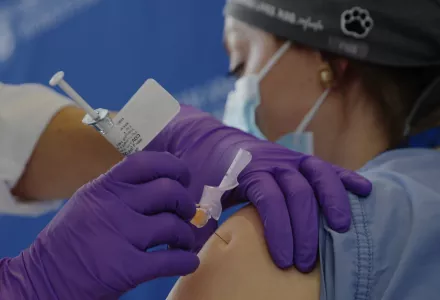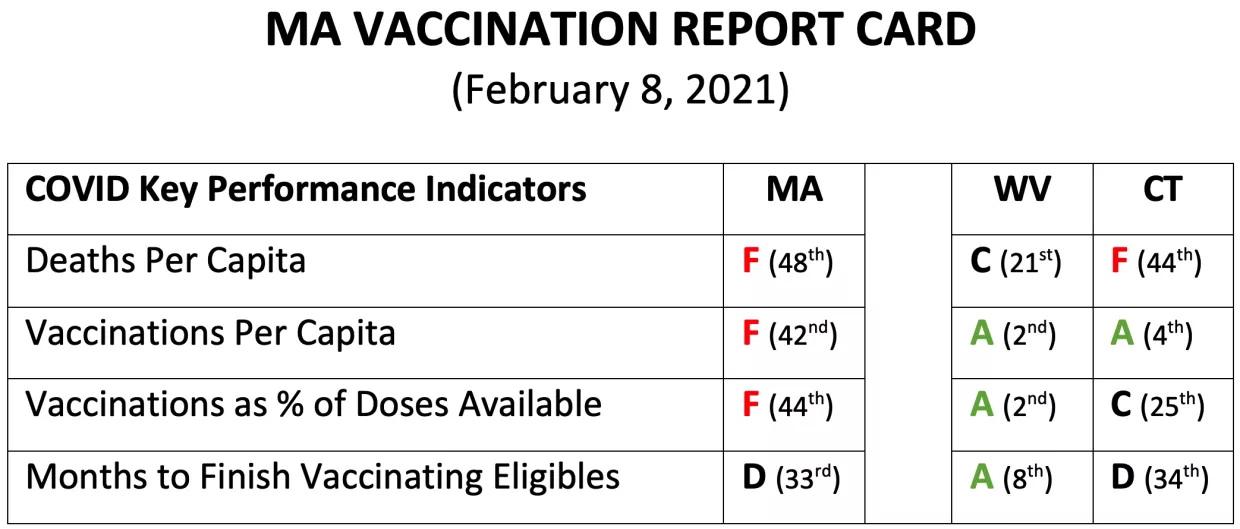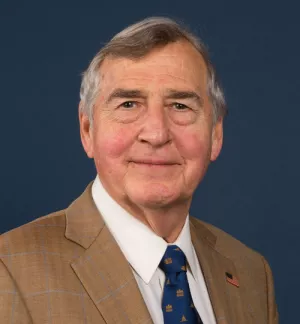
That Massachusetts has been stumbling in its attempt to meet the challenge posed by COVID-19 is not news. Many readers may, however, be surprised when they see the Massachusetts Report Card below. Among the 50 states in the union, on three of the four key performance measures, Massachusetts is currently earning an F.
Grim statistics about this killer disease have been repeated so often that they become numbing. But we should never forget that every one of the 2.3 million deaths to date was someone’s mother or father, sister or brother, colleague or friend. So too with our 460,000 fellow Americans who were alive when coronavirus arrived in the United States 12 months ago but are now gone.
The tragic fact is that most of these deaths were unnecessary. To put the point more provocatively: most of these deaths would not have occurred if our federal and state governments had taken actions they could have—but failed to do.
Since we understand that this is an incendiary charge, let us explain why. Because our nation’s performance has been so appalling, under former President Trump, Washington did everything it could to deny the relevance of comparisons of our results with those of other nations. Nonetheless, it is a simple fact that Singapore, with a population essentially the same as that of Massachusetts has had only 29 deaths. Taiwan with a population three times the size of Massachusetts has allowed only 9 deaths. And South Korea, with a population of 52 million, including 28,500 American servicemen, has experienced only one fiftieth the deaths per capita of the USA.
For those who live here in Massachusetts, that means that if our fellow Bay Staters who died in the past year from COVID-19 had relocated to Taiwan or Singapore or Seoul this time last year, they would be alive on this earth today. While certainly not the only reason, President Trump’s blatant failure to meet the coronavirus challenge certainly contributed to his being fired in the November election.
International comparisons aside, within these United States, 50 state governors, their health departments, and health providers each face an essentially equivalent challenge from this deadly virus. In combatting it, many are doing significantly better than others. To sharpen the point once more, had many of those who were killed by coronavirus in the past year moved from the state in which they had lived to one of the other states in the country, they would now be alive.
One of the great strengths of the American system of government is that our 50 states are “laboratories of democracy.” Lessons learned in one in reducing infant mortality, promoting racial harmony, or maintaining highways can be adapted and applied in others. Our 50 states are also competitors, indeed fierce competitors. They compete in attempting to persuade their citizens not to move elsewhere. They tout the advantages of their state, sometimes even providing tax incentives, to attract major businesses to locate their headquarters and manufacturing plants there. They compete to attract talented individuals in the hope that they will create new enterprises that will produce well-paying jobs for their residents. Indeed, they’ve even been known to persuade star athletes to “come home to Cleveland,” as Ohio did in the case of LeBron, raising the Cavaliers from the bottom to a championship in the NBA—or even to try to persuade Tom Brady to stay.
So if we compare the states to 50 runners in a series of marathons, we can see who is leading—as well as who is bringing up the rear. In the first race to protect the lives of its citizens and thus have the fewest deaths per capita, at this point Massachusetts has fallen so far behind that it is almost impossible for it to catch up. But in the second, the race to use the vaccines delivered to it weekly to vaccinate its citizens, every day Governor Baker, his Secretary of Health and Human Services, and the health providers are making decisions that can move this needle. If tomorrow, and the day after, and the week after that we run faster in this marathon, we will move up in the race for the highest percentage of our population vaccinated. Moreover, if the governor and his team are able to do that, they can advance the date in which we’ve reached the level of vaccinations that will allow us to return to something closer to normal.
In sum, in this marathon, cheering from the sidelines, we should all be shouting our words of encouragement: run, Charlie, run. Personally, I look forward to the day when our state’s report card will show A’s rather than F’s.

Allison, Graham and Hugo Yen. “Massachusetts Vaccine Report Card.” Belfer Center for Science and International Affairs, Harvard Kennedy School, February 9, 2021




